Mohit Tater's Blog, page 595
January 10, 2019
Guidance for PCI DSS

Any business that accepts credit cards
online for good or services rendered needs to comply with the Payment Card
Industry Data Security Standard (PCI DSS).
PCI DSS comprises of several guidelines
that merchants must comply with to protect their customers’ credit card data.
However, many companies struggle with security requirements. In most
organizations, InfoSec managers are not sure whether their networks and systems
fall under the PCI DSS scope.
What
is PCI DSS?
PCI DSS is an acronym for Payment Card Industry Data Security Standard. The five major payment card companies created the security standard: Visa, MasterCard, JCB International, Discover Financial Services and American Express, and provides the best practices for handling and storing cardholder data (CHD).
PCI DSS requirements are a series of
standards for processing card payments that protect both merchants and
consumers. These standards are generally referred to as the Payment Card Data
Security Standard.
Understanding
Cardholder Data (CHD)
PCI DSS defines cardholder data (CHD) as
any information that can identify a person and link them to a credit or debit
card. The personally identifiable information (PII) may include the name
of the customer and their address.
Apart from PII, cardholder data includes
the primary account number (PAN) of the cardholder, together with the card
service code and expiration date.
Securing
Cardholder Data Environment (CDE)
Cardholder data environment (CDE) refers
to any infrastructure or systems that process, transmit or store cardholder
data.
The infrastructure includes components
such as computers, applications, and networked devices that have direct or
indirect contact with cardholder data. These infrastructure components must be
PCI DSS compliant.
Network
Segmentation
The PCI standard requires the cardholder
data environment to be separated from other systems or components used by your
organization. Any devices connecting to the CDE through insecure connections
could put your firm at risk of third-party intrusions and, consequently, heavy
fines by regulatory bodies.
Overview
of the PCI DSS Scope
For your firm to be PCI-compliant, you
have to determine the CDE. Make a list of the networks, systems, applications,
and devices that interact with CHD and are, therefore, part of the CDE.
All the systems and components that
transmit, handle or store CHD in any form should be separated from the other
infrastructure and secured according to PCI requirements.
Importance
of Creating a Data Flow
It is essential to know the exact steps
that data follows when it is transmitted, managed and handled in your IT
infrastructure. For example, your network may be set up to store CHD and, at
the same time, receive data from a non-cardholder application.
In such a case, the non-cardholder
application will have to be secured according to PCI standards since it is in
the CDE. If the user is not protected, a malicious intrusion through it can
compromise the CDE.
Understanding how data flows in your IT infrastructure is critical to determining the security measures to implement for risk mitigation and prevention.
What
is an SAQ?
The PCI Security Standards Council has a Self-Assessment Questionnaire (SAQ) that merchants can fill to review their technology and find out whether they are PCI-compliant. The SAQ limits the CDE and makes it easy to identify which infrastructure components fall under PCI DSS scope.
Merchants that take credit card payments
physically at their establishments can use PCI SSC approved point-to-point
encryption (P2PE) devices to be PCI DSS compliant. This lower compliance standard
applies to merchants that:
Process payments using
PCI DSS-approved P2PE devicesHave P2PE devices that
only interact with their approved Point of Interaction (POI) devicesHave implemented all the
required P2PE controlsDi not collect, transmit
or store electronic cardholder dataDo not store legacy
information electronically
The lower PCI-compliance standard is
applicable for brick-and-mortar stores that use PCI-compliant devices and do
not store electronic cardholder information in any form.
PCI
Compliance Audits
Your organization’s PCI compliance must be
overseen by third parties known as Qualified Security Advisors (QSAs). These
auditors are trained in PCI compliance and will review your cardholder data
environment to ensure it is appropriately secured.
If your organization uses a
Software-as-a-Service (SaaS) platform to process payments, the platform is also
considered part of the PCI compliance scope if it stores, processes or
transmits CHD. For this reason, it is critical to establish whether the payment
platform you may want to use is PCI-complaint.
Vendors need to provide the following
documentation to prove compliance:
Independent assessments
carried out annually and presented to their customersMultiple on-demand
evaluations that may be required by users
Use
Compliance Software to be PCI-Compliant
You can use various programs to meet your
firm’s PCI compliance requirements. The compliance software will act as a
single-source-of-information, enabling you to see your current security controls.
You can then map your organization’s controls align with PCI DSS requirements.
Author Bio

Ken Lynch is an enterprise software startup veteran, who has always been fascinated about what drives workers to work and how to make work more engaging. Ken founded Reciprocity to pursue just that. He has propelled Reciprocity’s success with this mission-based goal of engaging employees with the IT governance, risk, and compliance goals of their company in order to create more socially minded corporate citizens. Ken earned his BS in Computer Science and Electrical Engineering from MIT. Learn more at ReciprocityLabs.com.
The post Guidance for PCI DSS appeared first on Entrepreneurship Life.

Tips for Creating Effective Brand Awareness

It’s not news that brand awareness is essential for businesses to thrive. But building brand awareness in today’s marketing climate is much more than simply running ads or buying a domain name. Having an active online and social media presence is important, but the online space is over saturated with ads, raising prices and lowering impact.
Creative thinking is essential in crafting successful brand awareness strategies that stand out. Below are some tips to bear in mind when creating brand awareness initiatives.
Get To Know the Consumer
Understanding who comprises your target market and what they want is essential for raising brand awareness. Often it is the case though that an unanticipated demographic interacts with a brand because it’s being used in unexpected ways. StickerYou for example, an e-commerce store specializing in user-made customizable stickers assumed their customers would mostly comprise of young people and artists. Although this indeed became the case, the company also found that other businesses were using their customizable products to further their branding and promotional incentives. By paying close attention to who was buying our products, we were able to adjust branding awareness strategies to include this new audience.
Make an Emotional Impact
It’s not enough to highlight what a product or company does. Successful brand awareness initiatives hinge on how the brand makes consumers feel. Evoking an emotional response with branding efforts can help connect the brand with consumers in a memorable way. And the emotion doesn’t have to be the standard “happy.” Highlighting how a product or service can solve a problem for a customer can foster feelings of trust and safety. By focusing on a specific emotional response, brands become more relatable, and by proxy, more trusted.
Cross-Promote
Traditional and outbound marketing still prove effective in terms of brand awareness because they are successful ways to ensure products or services are seen by customers. The problem is that audiences who aren’t interested in the brand are going to ignore these efforts. Targeting specific demographics and increasing brand awareness to tap into new ones works best with cross-promotional tactics, as this helps expand brand awareness via each customer base. Having an e-commerce store cross-promote in a physical brick-and-mortar location for example can be a mutually beneficial strategy. The brick-and-mortar helps the e-commerce store by exposing the brand to an audience that might spend a lot or any time online. Conversely, an e-commerce store can promote online exclusive deals to increase the brand awareness of the brick-and-mortar.
Team Up with Influencers
Establishing relationships with influencers that operate in a niche market and focusing on a specific product or service is useful in increasing brand awareness. For example, at StickerYou, we promote the ability to customize sticker designs using our online Sticker Maker tool. This ability to customize designs appeals to street artists who want to create stickers to promote their work in their own networks, which are often niche target audiences interested in art and design. By working with street artist influencers, we are able to engage with their target audiences in a more meaningful way than if we were to try to access these audiences on our own. We often post blogs featuring the creative work of artists that have purchased from us that they can then share on their own social channels and networks. This way, both parties gain increased brand awareness and exposure in different specific market segments.
Package Makes Perfect
Putting the finishing touches on orders via branded packaging is an easy, affordable, and unique way to raise brand awareness. Having a visually pleasing and functional package advertises a brand not only when the customer receives it, but also while the package is in transit. Branded packaging can make a lasting impression that encourages repeat purchases and positive word-of-mouth references.
Raising brand awareness is an important element in growing a successful business. Knowing who the customer is, evoking an emotional response, and spreading the company message via influencers, creative promo campaigns and packaging allow brands to affordably increase brand awareness in creative ways.
Author: StickerYou Founder & President, Andrew Witkin

As the founder of a global e-commerce leader in custom-printed, die-cut products, Andrew Witkin is widely recognized as a leading authority on e-commerce, customization, startups, marketing and the tech economy. Witkin has also served as VP North American Licensing for Nelvana/Corus Entertainment and Director of Marketing for MegaBrands/Mattel.
The post Tips for Creating Effective Brand Awareness appeared first on Entrepreneurship Life.

The world’s Best Hotels for Business Travel

Traditional offices and chained-to-desk positions are no longer as commonplace as they used to be. Workspaces are popping up left and right, catering to the growing population of remote workers (Fast Company called remote work “the new normal”). Coffee shops are doubling as temporary offices. And hotels are developing well-planned business centers for business travelers.
All around the world,
hotels are designing spaces that cater to business people whose positions are
transient. Whether you’re looking for the perfect hotel in Tokyo to host an
entire company, or simply an ultra comfortable room to independently handle
some business in New York City, there’s an unique option out there for you.
The key is to choose
hotels that are known for catering to business travelers. Some hotels focus on
tourists; others on long-term guests. By understanding which hotels operate
with your lifestyle in mind, you’re putting yourself in a much better position
to enjoy your stay and get some work done. Here are some of the world’s best
hotels for business travel:
Concorde
Hotel, New York
When it comes to New York, business travelers are everywhere. And business hotels are a dime a dozen. But in a city inundated with hotels, it can be difficult to choose the right one. The boutique Concorde Hotel in New York City is ideal for business travelers seeking to combine luxury comfort with efficiency. For travelers not just looking for a room—but a temporary home—Concorde is ideal.
Suites and penthouses
are designed with the business traveler in mind: luxurious, high-end
comfortable furniture spans throughout the layout, making it easy to get a good
night’s rest after a long flight. The hotel is also centrally located, making
it a simple access point for reaching meetings throughout the city. With a
complete business center at your disposal, combined with printing and mail
services and fast WiFi, there’s nothing you won’t be able to get done here.
Manchester
Grand Hyatt, San Diego
Standing tall in the heart of Downtown San Diego is the Manchester Grand Hyatt equipped with 100,000 square feet of indoor meeting space. This makes it the perfect space to do everything from independent work to gathering entire teams or using the hotel as a base to host a work retreat. There’s also plenty of event space, as well as easy access to a championship golf course and nearby beaches.
The
Peninsula Hong Kong
Tokyo is one of the biggest cities in the world for business, and the Peninsula in Hong Kong lives up to the challenge. In a study conducted by Fortune Magazine Travel + Leisure, Peninsula was ranked one of the best hotels for business travelers. A bedside panel makes it easy for travelers to control everything from the television to the thermostat to the lighting to concierge requests—all with the touch of a few buttons. Gyms and business centers are available 24/7. Guests are even transported from the airport to the hotel in a Rolls Royce or BMW that’s equipped with WiFI.
Hilton
Anatole, Dallas
There are many things a business traveler needs, and the Hilton Anatole in Downtown Dallas, Texas ticks several boxes. The hotel boasts three executive floors, over 50,000 square feet of event and meeting space, and an on-site FedEx center. It’s also located in a prime area (near multiple main attraction), and several boardrooms offer skyline views. No matter what you need to get done, Hilton Anatole make it’s easy to do business.
Orchard
Hotel, Singapore
The Orchard Hotel in Singapore offers packages dedicated exclusively to business travelers. For example, the Executive Club Deal considers the meeting-to-meeting lifestyle of the average business travel. It comes with limo rental services, shoe shining services, complimentary laundry, and evening cocktails.
Its 13 function rooms
have a team award-winning chefs and event planners who can help coordinate your
events and ensure they’re running as smoothly as possible. What’s best is that
rooms here run as low as $150 per night.
Waldorf
Astoria, Chicago
The Waldorf Astoria in Chicago was rated the best hotel in the United States by Conde Nast Traveler. The rooms have terraces, soaking tubs, and marble floors. In the Balsan Private Dining Room, an entire team of business travelers can be treated to a private meal during a meeting break. All Waldorf properties are equipped with unique boardrooms. The Chicago location boardroom, called the Hemingway Salon, is decorated to represent 1920s Paris with high ceilings, natural light, and elegant fittings. There are eight meeting rooms and a formal ballroom, and private dining room for groups as well.
The post The world’s Best Hotels for Business Travel appeared first on Entrepreneurship Life.

January 9, 2019
Jacques Poujade Shares: 5 Questions To Ask Your Mortgage Broker When Buying A Home?

Jacques Poujade is a financial industry executive, with more than three decades of experience. During his career, he has worked in prominent roles in Canada, the UK, and the US. Therefore, he has the practical knowledge to help budget conscious entrepreneurs, from a range of backgrounds, obtain real estate financing to buy their ideal home. These days, he leverages that expertise at the non-bank mortgage provider, LendPlus. Here he shares five questions he commonly gets asked and that you, too, should ask your mortgage broker when buying a home.
1.
What Documents do you Need to Process my Loan?
You should ask this question upfront, so
you will have plenty of time to get your documents together. Proof of Income
enables lenders to check that your earnings are sufficient to cover mortgage
payments and living costs (i.e. utility bills and furnishing costs). Lenders
will gauge your risk profile by researching your credit history too.
Frequently, lenders ask for documents like
bank statements to ensure that mortgage applicants have the funds to cover
several monthly mortgage payments. This is just in case anything unexpected
occurs – like having an accident that prevents you from working, or
unexpectedly losing your job. Lenders may wish to see your tax return as well
to check that the information you gave to the IRS corresponds with the income
report you submitted to them.
2.
Am I Eligible for an FHA Loan?
FHA loans are specialized loans provided by
the FHA (Federal Housing Administration), which enable people with zero credit
or bad credit to acquire mortgages. Usually, these loans are given to first
time house buyers. The FHA permits these buyers to buy a house for a mere 3.5
percent down payment, in some cases. This makes home ownership possible for
many more people. A minimum credit score of 580 is required for approval.
3.
How Much Money Should I set Aside for Closing Costs?
Generally speaking, sellers pay closing
costs, although sometimes, they might negotiate with buyers to split the cost.
These costs include recording fees, commissions, title insurance, and mortgage
fees. Buyers who have mortgage insurance with an annual payment option pay
their lender the initial twelve month’s premium upon closing. Buyers who opt
for monthly mortgage insurance payments only must pay their lender for one
month upon closing.
Long story short, when determining how much
you can put down on a house, you should include ancillary fees like closing
costs and/or mortgage insurance.
4.
Can I Pay Off My Mortgage Early?
Yes, absolutely. If you wish to release
capital for other purposes, or lower the total interest charged for your
mortgage, paying your mortgage off ahead of time could help. You make interest
payments on your remaining balance every month your mortgage exists. If you pay
off your balance early, you will avoid years of additional interest on the
loan.
Also, fully paying your mortgage off
increases your monthly cash flow. This eases the financial burden on your home
and provides you with extra resources to save or invest. Over the long term,
this approach could give you bigger returns.
5.
Can I Benefit from Mortgage Insurance or PMI?
Yes, mortgage insurance gives lenders a financial guarantee that protects them, if borrowers default on their loans. If you want to purchase a house, signing up to loan conditions that feature mortgage insurance boosts your buying power to a large extent.
By purchasing mortgage insurance, you have
the chance to buy a house with a five to ten percent down payment, rather than
the twenty percent that is frequently needed if the lender isn’t protected by
mortgage insurance. This is an ideal option for would be borrowers, who cannot
make big down payments.
Connect with Jacques If you would like to receive further advice relating to finance and real estate, you can follow Jacques Poujade on Twitter and Facebook for his latest thoughts. He also covers these subjects in considerable detail on his personal website, JacquesPoujade.com
The post Jacques Poujade Shares: 5 Questions To Ask Your Mortgage Broker When Buying A Home? appeared first on Entrepreneurship Life.

3 Due Diligence Points for Mortgage Lenders

A combination of the 2008 financial crisis and the expansion of Fintech has caused large swaths of retail investors to dabble in the mortgage lending markets. While banks scaled back their debt portfolios after the Great Recession, other financing businesses quickly occupied the newly-vacant space. In this article, I will highlight three points of due diligence for investors who are interested in mortgage lending to consider.
#1: What rank is the mortgage?
A mortgage
is a legal tool that is used to secure a debt against real estate. Ultimately,
it stops the debtor from selling a property until secured lenders are repaid in
full.
A piece of
real estate can have multiple mortgages registered against it. This is a
concept known as “lien priority” or “rank.” For instance, let’s assume that Joe
purchased a house in 2010. He paid $500,000 for it, which included borrowing
$400,000 from the bank. The bank placed a mortgage on his home. It will be
lifted once Joe’s debt to the bank is paid off.
In 2012,
Joe borrowed $50,000 from you. Since you wanted collateral for the loan, you
required him to allow you to register a second mortgage on his residence.
Now, let’s
say that Joe wants to sell his house in 2019. After listing it on the market
for two months, he is able to earn $600,000 from it. Before he can retain any
of the proceeds, he must first repay the bank. Then, he has to pay you back.
After both secured creditors recoup their funds, Joe can keep what remains.
Rank is
important because it is directly correlated to risk. The earliest lenders get
their money back first. The deeper down the ladder one goes, the greater the
chance of not being repaid if the borrower defaults.
#2: What is the loan-to-value ratio of the
property?
Assessing
the mortgage rank is important, but it’s not enough for complete due diligence.
The lender must also know how much debt there is on a property when compared to
its worth. This is a concept known as the loan-to-value ratio or LTV.
In the
prior example, we saw that Joe’s house was purchased for $500,000. It had two
mortgages on it: the first for $400,000 and the second for $50,000. As such, it
had a cumulative debt of $450,000, which is 90% of $500,000. As such, the LTV
was 90%.
However,
Joe’s property price increased over the years. By the time 2019 came around,
the house was worth $600,000. Thus, the LTV ratio was reduced to 75%. In fact,
he was likely making principal payments to both you and the bank, so the LTV
would have dipped even further.
LTV matters
because it helps the lender understand how much room there is for the real
estate’s price to decline. If it falls below the value of the mortgage, then
there is a high risk of the lender losing money if the borrower defaults. This
is called being “underwater.” Sadly, it was all too common during the 2008
economic collapse.
As an
example, let’s say that the economy slows down. People now have less disposable
cash, so they’re unable to purchase homes as frequently. This places downward
pressure on all houses, causing the price of Joe’s to plummet to $420,000. Six
months later, he loses his job and can’t meet his obligations on either of his
mortgage loans.
After
repeated warnings, the bank loses patience with Joe. It files a lawsuit against
him and moves to foreclose on his property. The court approves a sale of the
home at market price, $420,000. As such, the bank recoups its money and can
move on.
After
paying back the bank, there is only $20,000 left. All of that goes to you. But
you loaned $50,000, so you’re still out $30,000. You’ll now have try to collect
the balance from Joe’s remaining assets, which can be substantially more
difficult.
We can
therefore see that lending at a 90% LTV was a costly decision. So, what is a
good loan-to-value ratio? 30%? 50%? 80%? There is not a perfect answer to this
question. However, many in the industry consider 75% to be comfortable. That
number provides for a property devaluation of 25%.
It is
critical to note that our discussion of LTV thus far was a bit simplistic.
Oftentimes, the court will approve a sale of the property at below market
value. That can skew the picture. Further, the lender will probably incur legal
fees during the foreclosure process. These are usually tacked onto the balance
of the borrower’s debt. But they should be accounted for, or at least
considered, in the LTV equation.
For
instance, in Joe’s case, the bank may have spent $10,000 on attorney fees to
foreclose on the home. Thus, his debt to the bank would have increased to
$410,000. That eliminates another tranche of capital that could have otherwise
gone to you.
#3: What is the borrower’s exit strategy?
The lender
should know how the borrower intends to repay the debt. It might be through a
property sale, from a refinance or via generating capital in another way. But
regardless, it is risky to give a loan without knowing how it will be paid
back. It could result in the borrower’s inability to repay the loan by the
agreed-upon maturity date.
Conclusion
Mortgage
lending can be a good investment. Among other things, it can provide for
security in real estate and consistent interest payments. However, it can be
risky if done incorrectly. The foregoing three points are just the tip of the
iceberg. Thorough due diligence will call for a comprehensive review of the
borrower, the asset, the local market and the economy in general.
Further,
some jurisdictions require a license to be a lender. Before embarking your
journey as a private debt financier, it may be worthwhile to consult with an
attorney. That person could be useful to you later on, as well. You will likely
need help with legal documentation, such as promissory notes and mortgage
agreements.
Author Bio

Alexis Assadi is an investor, writer and entrepreneur. He operates various financing companies, including Pacific Income Capital Corporation and Assadi Capital Corporation. Alexis lives in Vancouver, Canada with his family.
The post 3 Due Diligence Points for Mortgage Lenders appeared first on Entrepreneurship Life.

How to transfer WhatsApp Messages from iPhone to Android
It is never easy to switch from iPhone to Android as data transfer from one device to another becomes a difficult task to deal with. For example, Whatsapp transfer is a time consuming and tedious affair across any iOS to Android platform.
Of course,
while hunting for how to transfer WhatsApp chats history from iPhone to Android
you may get a list of different solutions. But, not many of them are remotely
functional and would save your time. So, to make everything simple and
effective and to avoid multiple attempts to carry out the WhatsApp transfer
from iPhone to Android you need to rely on a well- structured program that is
useful and convenient.
Well, if you are still searching for one but haven’t been successful in getting any then we will help you discover the right solution that is already tried and tested so that you do not have to invest your valuable time in knowing about the transfer process. iSkysoft Toolbox is an easy and time saving transfer solution that helps you transfer WhatsApp messages from iPhone to Android successfully within a few clicks.
Part 1: iSkysoft Toolbox – Best program that helps transfer WhatsApp from iPhone to Android
iSkysoft
Toolbox- Restore Social App is well-designed software that lets you transfer
WhatsApp data from iPhone to Android following simple steps that just takes a
few seconds. The easy steps enclosed in the transfer process makes the tricky process
of transfer faster.
Just follow
the steps given below carefully to discover the extremely simple and automatic
transfer process.
Step 1. On
your computer- Install the software- iSkysoft Toolbox. Now connect iPhone and
your Android device to your PC with the help of an USB cable. Run the program –
iSkysoft Toolbox and click- “Restore Social App” to start the process.
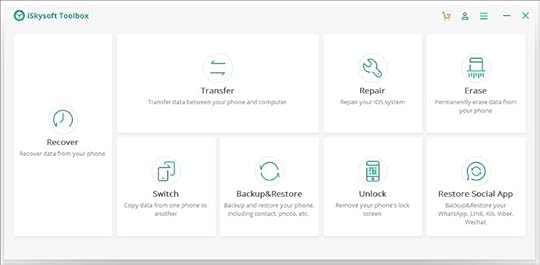
Step 2. The
next screen will display 4 options. On the left hand side you will be able to see
the option – “WhatsApp”. Just click on it. Now you need to click on the option
– “Transfer WhatsApp messages” to begin the transfer.
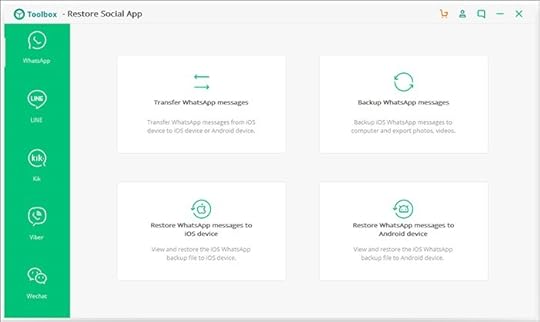
Step 3. To
initiate the process click – “Transfer”. Ensure that the connection is not lost
between your phones and PC.
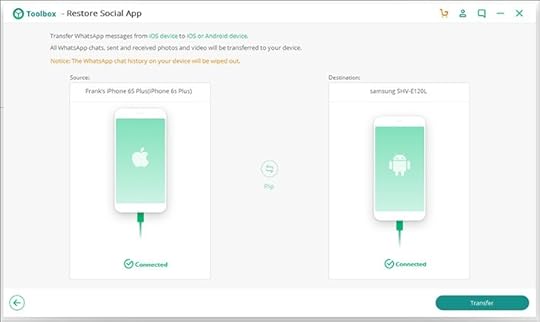
Step 4. At
this point, the software will ask you to type in your Google play account to
initiate the process of retrieving WhatsApp data. You can skip the process in
case you don’t possess a Google Play ID.
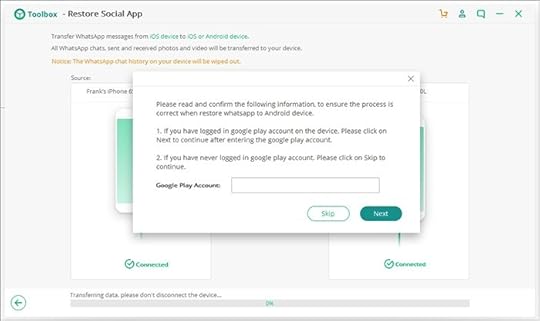
Step 5.
Halfway in the process, you will get a message seeking your permission to
overwrite the current WhatsApp messages on the target phone. Simply click –
“Yes” to continue.
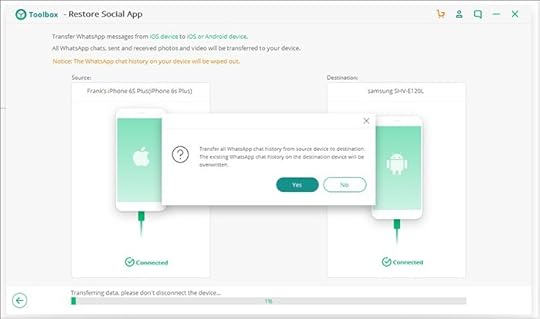
Step 6. Now
you will be able to view the window as shown below after your WhatsApp messages
are transferred successfully.
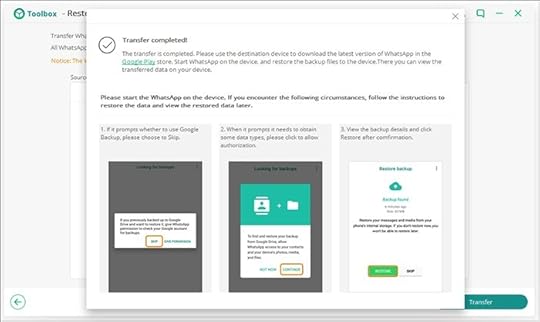
iSkysoft
Toolbox- Restore Social App treats transfer process in a simplified manner and
has a range of features.
Transfer your WhatsApp documents,
messages, photos, videos etc. from iPhone to Android easily.Transfer process takes less time and
the screen instructions are easy to follow.You can preview your WhatsApp data
before you choose to restore which helps you restore preferred messages
selectively.Within a single click you can also
backup WhatsApp messages to your computer.Supports an array of newest versions
of iOS devices so, iSkysoft Toolbox is compatible with almost any iOS device
you own.Offers WhatsApp data transfer from
iOS to iOS/Android devices too.
iSkysoft Toolbox- Manages messaging
apps with ease
Using a different messaging app other than WhatsApp? No worries! iSkysoft offers backup, transfer and restore features for other messaging apps too such as Viber, KIK, WeChat, and LINE. So, it becomes easy to manage your messaging apps no matter whether you decide to buy a new phone or want to backup your data to store them in a secure manner.
iSkysoft Toolbox – User friendly and
clean interface
The user
friendly interface and step by step guides lets you crawl through simple
process in a few clicks. You don’t have to face any data loss during the
transfer process. Your data security and privacy is managed well with iSKysoft
Toolbox. You don’t need to worry about your data being transported to any
external sources as data is secure on iSkysoft Toolbox platform only.
iSkysoft
Toolbox supports Operating systems like Windows and Mac. Now you don’t need to
look for different solutions for backup, transfer or restore WhatsApp data as
iSkysoft Toolbox offers one solution that helps meet all these needs.
Conclusion
You may try a
different ways to transfer whatsapp from iphone to android, but if you are
looking for a reliable, faster and easier way to do the transfer and restore
your WhatsApp messages safely and selectively then iSKYsoft is certainly the
ideal solution. It is just one solution that can meet your transfer, backup and
restore needs.
The post How to transfer WhatsApp Messages from iPhone to Android appeared first on Entrepreneurship Life.

January 8, 2019
5 Tips for Managing Money in Retirement.

Retirement is that time you want to relax and
enjoy life with your loved ones. Managing money during retirement is somewhat
easier because your sources of income are rather limited. As such, you want to
be more disciplined with your spending without being too frugal. This guide
offers five tips on how you can manage money during retirement.
Convert Home Equity to Income
Home equity makes a great source of income for homeowners in their retirement. There are several ways of converting such capital to income that helps them during this time. First, they can downsize to a small space. This alternative is ideal for homeowners living in extremely expensive neighborhoods or houses that are extremely large for the senior’s needs. Another way of converting home equity into a source of income is to apply for a reverse mortgage. This loan is designed to eliminate ongoing mortgage payments and take out a loan against your home, though the borrower retains ownership of the property.
Have a Plan for Out of Pocket Health Expenses
Most retirees account for fixed expenses like utility bills and property taxes when making a retirement budget but leave out medical expenses. Admittedly, it is difficult to plan for health expenses. Plans such as Medicare don’t always cover 100% of health care costs hence, the need to anticipate for out of pocket expenses. Health insurance policies also come in handy, but they also don’t cover all the medical expenses. Retirees can open a health savings account which helps account holders prioritize retirement savings. The savings are tax deductible, the interest is tax-deferred, and you can spend the money on medical expenses without any tax implications. Another way of planning out of pocket health expense is to take out a whole life insurance policy. Find an insurance company that will sell life insurance policy which allows you to take out a loan against the policy during an emergency. Alternatively they can enroll to Medicare Supplementary plan. The traditional Medicare plan only covers a part of the healthcare cost, but the Supplementary program covers the remaining cost of medical expenses.
Talk with Family
A family is a great source of joy, especially
during old age. This does not mean you should spend all your retirement money
helping out adult children. Keep in mind you don’t have as many opportunities
to make money; you can only make the best of what you have hence, the need to
account for every expense.
Wait as Long as Possible to Start Social Security
Social Security provides fixed monthly income for as long as you live, so you want to wait long enough before you start using social security. The difference in the value of your social security when you are 65 and 70 years can be hundreds or thousands of dollars. If you have other sources of income, you should consider delaying until an older age. This way, you enjoy a higher standard of living, especially when your body is not as strong to work.
Make Trade-Offs
Some retirees are tempted to travel places they
desired to go for years. When it is a great way to relax and enjoy life, you
need to focus on what is important. If you still want to visit Paris, you need
to plan and make several cutbacks.
The post 5 Tips for Managing Money in Retirement. appeared first on Entrepreneurship Life.

January 7, 2019
How to use content to drive PR

Consumers are getting smarter about marketing, and the avenues which were once staples no longer reach them. In fact, engaging in spam tactic style PR stunts could even cause consumers to react negatively to your brand. So, what’s a new business owner to do? You obviously need to build brand awareness, but how do you do it in a way that makes people love your brand rather than loathe it? The answer is creating amazing content that creates good public relations.
How do you make good content for PR?
Good content makes people stop what they’re doing and share it. It’s interesting, it’s informative and it’s your ticket to the front page of top social media sites like Reddit or directly into the feeds of consumers on Instagram. However, consumers aren’t dumb, and you can’t just put up a thinly veiled ad for your company in the hopes that they will share it. This type of activity is actually more likely to create a negative brand image when these users figure out your game plan.
Instead, focus on content that’s useful and doesn’t try to sell anything. Of course, the content you share should be relevant to your products, and that’s why identifying your target audience is key. Valuable evergreen content like tutorials and how to guides on a variety of subjects from health to fashion are often the best ways to market your brand. Every niche can benefit from this type of content, and it’s an easy win for you.
Need some ideas for your viral content? Spend a few days browsing through relevant niche groups on Reddit to see what kind of content makes it to the front page. Odds are, you’ll be able to get some great ideas for your own marketing plan that can help your brand to outshine the competition.
No one knows your brand, product and/or service than you do. Outsourcing your digital PR to an agency can be an option for bigger companies. But in today’s digital world, you don’t need a PR agent to reach media and blogs. You can simply use Contento to get your articles placed on top sites. Also see article “Do You Actually Need A PR Agency?“
How to use quality content to get your brand on high authority websites
The name of the game here is outreach, and it’s not an easy task. Be prepared for the disappointment of getting one successful placement for every fifty or so emails that you send out to publishers in your niche. While this can be a little soul crushing at first, the rewards are worth the trouble, because guest posting your content on to popular blogs in your niche puts your brand in front of your target audience in a way that advertising will never be able to do.
The PR boost for guest posting is so massive because these publishers have cultivated an audience. That audience trusts them, and some of that trust flows back to you. However, if you don’t really have time for manual outreach, then there are services out there that can help. These agencies do the heavy lifting of placing your PR content on niche relevant blogs so you can get back to running your company.
Using a PR agency will take a little money out of your pocket, and it will put a lot more time back into your day, but it’s up to you to decide how much your time is worth. The good news, of course, is that these types of services are getting more and more affordable, and many of them will even allow you to start for a relatively nominal cost, allowing you to scale your PR efforts as your business grows and your marketing budget gets a little fatter.
How good content boosts your search rankings
Link building is still one of the most important aspects of SEO, and high-quality content not only boosts your company’s PR, but it can also benefit your search rankings as well. Evergreen content that teaches people how to perform a skill or task is not only routinely shared on social media, but it also gets linked to by other sites forever.
That’s part of what makes content-based digital PR marketing one of the most effective marketing strategies, because while an advertising campaign may only bring in business for your company for a few months while the ad is running, quality content continues to bring in money year after year, making it one of the best returns on investment when it comes to marketing.
While you should, of course, put out high-quality content for your guest posts, it’s also important to save the very best posts for your own website. Hosting massive guides that have the answers that consumers are searching for lends you authority, and soon they’ll see you as an expert in your field and trust your products that much more.

The post How to use content to drive PR appeared first on Entrepreneurship Life.

How to Pull your Small Business Out of a Cash Crunch?

From
a very early stage in life we are taught that failure means the end but
reflecting back at history, it can be appropriately said that failure is just a
stepping stone for success. Sometimes before a business finally leaps for the
positive slope on the progress-time graph it takes a steep negative slope. Most
successful businesses today are the ones that pulled their enterprises out of
there instead of giving up. We have compiled a few suggestions for you, that
might give you an insight in pulling your business out of a cash crunch.
Frequent SWOT Analysis
SWOT stands for Strength, Weaknesses, Opportunities and
Threats. A good quality SWOT analysis will help you monitor the progress of
your enterprise and predict its rise and fall. Such predictions might come
handy in preparing beforehand for the losses and might save you from the panic
attacks.
Value your customers
According to Gartner statistics, eighty percent of a
company’s revenue comes from twenty percent of its customers. Know those twenty
percent customers and keep them close. Try involving them in your business
strategies and maintain your goodwill with them.
Invest in an Advisor or Mentor
One thing you can always learn from
is the experiences of people who took similar paths as you have chosen. A good
advisor would be a great asset not just in times of profits but more so in
times of loss.
Consolidate Debt
Try to combine your debts into a low fee and low interest
product. Try finding better deals while you are refinancing your current debt
arrangements. It could save you some trouble if multiple debts having varying
interest rates could be combined in order to have a relatively lower interest
rate.
Rely on Government Grants
When opening up a small business or enterprise, look out for
insurance policies and schemes that are meant to assist small-scale enterprises
and young entrepreneurs. Backup is great when considered from the very start.
Recover Outstanding Debt
While borrowing or lending money, always make sure you have a condition of sale agreement in writing that outlines your terms and conditions, very clearly. In times of occurring losses, chase up as many outstanding payments as you can. You can ever outsource your debt collection with a reputable debt collection agency.
Sell Assets
If you have some unwanted assets, which do not add up in your
profit equation, you could sell them and reduce your storage costs. To help you
spread the cost over a longer time period, you could also consider leasing your
assets, until you fully recover from the losses.
New Marketing Techniques
Times of traditional business settings are long gone. In this
era of social media and globalization, you might just be a few clicks away from
recovering your losses and elevate your enterprise. Make right and extensive
use of the World Wide Web and try to reach potential customers throughout the
globe. You can even offer additional payment methods online, which will open
for you different markets.
Good
businesses thrive on risks. But it is highly inadvisable to take those risks
without precautions. Moreover, it is important to not give up without trying
recovering your enterprise from a negative slope. Personal assets, help from
friends and family should be one’s first preference once all the precautions
are utilized exhaustively. It might take a whole of of perseverance and
patience but running your own enterprise despite all the losses that one might
face, is one of the most satisfying jobs.
The post How to Pull your Small Business Out of a Cash Crunch? appeared first on Entrepreneurship Life.

January 6, 2019
Odds and Ends: Making Your Store More Memorable (and Profitable)

Regardless of the type of store, there are
always some things that don’t really fit the mold, as far as their stated
intention is concerned. What this means is that even hardware stores or stationery
shops have chocolate bars in their checkout lanes and exciting items on the
ends of their aisles that might not directly fit into their chosen niche. The
items might be completely unrelated or might act to solve a common problem or
recurring complaint with the main products sold by the store.
This concept can be applied to both online
and offline stores. This isn’t entirely about impulse-bought items meant to
exploit the psychology of customers, but that’s not to say the money you
receive from impulse buying is any less green than the money obtained from
other products. In fact, having the right impulse-bought items that aren’t
easily found can easily make your store more memorable as a one-stop shop, or
give you an edge over people who are selling similar items. As far as online
shopping goes, having a few odds and ends can help your store. This is when a
customer is just below a certain threshold for something like free shipping or
a discount, and you give them the ability to take advantage of specific offers
on your site without making them feel cheated by having to buy another
big-ticket item just to qualify. While the price of these items might not seem
like they make for big profits, they typically have more significant profit
margins because you bought them in bulk, and they aren’t really specialized
items.
Let’s look at some examples:
Branded Clothing
Adding some peculiar items in the form of hats and t-shirts can be a boon to your bottom line. There are thousands of wholesalers now that deal in both branded and non-branded items of clothing like Wholesale For Everyone that enable you to order personalized clothing to sell at your store. Think abstract when wondering if this is the right choice for you. For instance, it might seem weird if a paint store was selling hats & shirts, but when you think that most people wear clothing they don’t particularly care about while painting under the expectation it’ll get dirty, a $5 t-shirt and a $7 cap can just become that much more appealing to the customer. Not only that, if you have enough return customers purchasing from you, they might end up buying one just as a utility item or even as something to sleep in. This is more likely to happen if they’re just a pinch shy of getting a deal on shipping or something, however.
“Bucket Handle” Style Products
What these kinds of products mean is that
while the bucket is an amazingly useful item, the bucket handle is innovative
and makes using the bucket much easier. Think about what kind of things you
sell, and then look for accessory products that compliment them. If you sell
brushes, selling something that makes a brush more comfortable in hand would
come to mind. Think about all of the products you have on offer, and do some
serious research into what people have invented to make using them simpler and
more stress-free.
Conclusion
The secondary or even tertiary items to the ones you sell mainly on your store can end up making just as much, or even more than your primary items, if you leverage interest in them properly. Adding extra items that remove problems from the existing ones might end up making you two sales you wouldn’t have made, instead of the customer passing entirely on your store. All of these things increase your customer’s experience with purchasing from you and make your store more memorable in the end. Ideally, your store can obtain, convert, and retain customers as easily as possible. A part of this is, of course, having the right inventory.
The post Odds and Ends: Making Your Store More Memorable (and Profitable) appeared first on Entrepreneurship Life.




